Intervention over Incarceration: A Limited Government Approach to Youth Violence
Author
Media Contact
For general and media inquiries and to book our experts, please contact: pr@rstreet.org
Executive Summary
Over the past two decades, community violence intervention (CVI) has emerged as an important violence prevention strategy. CVI programs rely on credible messengers to mediate disputes, conduct focused deterrence, provide service referral, and, most importantly, build genuine relationships with individuals at risk of experiencing violence. By treating violence as a public health problem, CVI programs represent a paradigm shift in protecting vulnerable communities. They remove law enforcement from the equation entirely, going beyond the familiar “limited government solution” framework to one that could be more accurately described as a “no government solution.” Policymakers and community leaders across the country need the latest information on this promising, non-law-enforcement approach to youth violence. Fortunately, in the past five years, a new generation of youth-focused pilot programs has added to the growing body of evidence demonstrating that CVI programs can help juveniles as well as adults. This paper presents evidence covering CVI’s history, theoretical framework, operating models, program evaluations, challenges, and policy implications and concludes with recommendations.
Introduction
Youth violence in the United States is a significant problem, second only to car crashes as the leading cause of death among children and adolescents. Nonfatal violence is even more widespread, with the rate of violent victimization for persons ages 12 to 17 more than doubling from 2021 to 2022. Traditional juvenile justice methods alone have proven insufficient to curb this devastating public safety issue. The goal of community violence intervention (CVI) is to reduce homicides and assaults through proactive, direct engagement with those most at risk of either perpetrating or being victimized by violence. Historically, CVI has been geared toward young adults, but recent initiatives have shown CVI can reduce youth violence as well. By shifting the nexus of violence prevention from the state to private individuals and organizations, CVI programs can shrink the footprint of the government and improve public safety at the same time.
Theoretical Framework
Origin of CVI
In the late 1980s and early 1990s, juvenile homicides in Boston more than tripled—from 22 in 1987 to 73 in 1990. To counter this alarming trend, city officials worked with the community to develop Operation Ceasefire, a radically different approach to violence that used direct deterrence rather than investigation and punishment. Beginning in 1995, Ceasefire workers identified young people with the highest risk of gun-related violence and contacted them face-to-face. Ceasefire workers communicated an unequivocal warning: If violence continued to occur, it would be met with a swift and certain response. This group accountability model served as a powerful deterrent. Within two years of implementing Operation Ceasefire, the number of youth homicides in Boston dropped to 10, with just one during all of 1999 and 2000. Overall, the project was associated with a 63 percent reduction in Boston’s youth homicide rate and significant reductions in shots fired, calls for service, and gun-related assaults. The improvements were so surprising that the program became known as the “Boston Miracle.”
For years, criminologists struggled to explain Operation Ceasefire’s amazing results. They knew it worked, but not how or why. Then, in 1999, an epidemiologist named Gary Slutkin developed a theoretical framework that explained Ceasefire’s success. Slutkin spent most of his career treating infectious diseases in Africa; this field experience shaped his ideas about violence prevention. After returning home, he noticed that patterns of urban violence in Chicago resembled the spread of infectious disease he had witnessed overseas. He observed that violence moved through neighborhoods like a contagion, with a single incident leading to even more violence, the same way infected cells become nodes in a network of viral reproduction. Without a sufficiently strong socioeconomic immune system to stop transmission, certain communities continue to be plagued by violence year after year. Embedded in this insight was an aspirational vision: If violence behaves like a disease, perhaps it can be diagnosed, treated, and even cured. By targeting the individuals most at risk of causing harm or becoming victims, it may be possible to “slow the spread” within communities infected by violence.
Based on this epidemiological model of violence, Slutkin founded an organization called Cure Violence, that works to reduce violence in three stages:
- Diagnose the Patient: Identify individuals at the highest risk of being involved in violence and conduct personal, one-on-one outreach via credible messengers.
- Interrupt Transmission: Use the power of personal relationships to prevent minor conflicts and petty arguments from escalating before someone is hurt or killed.
- Boost Immunity: Mobilize local residents to change norms that perpetuate violence, provide compelling alternatives, and build resilience.
Cure Violence is centered around violence interrupters—individuals rooted in the community with the specific knowledge and independence necessary to conduct street outreach, de-escalate conflicts, halt retaliation, identify the individualized needs of youth, and provide resources to disrupt cycles of violence. Most violence interrupters work independently of law enforcement, giving them additional credibility in the communities they serve, where trust in police is often low. Unlike law enforcement, violence interrupters’ goal is primarily to save lives, not necessarily fight crime. This epidemiological approach has since become common across the CVI landscape, reducing violence by up to 70 percent in diverse communities in the United States and around the world. Independently administered, multiyear scientific evaluations in communities that deploy CVI techniques document other positive effects, including higher employment rates, better educational outcomes, and increased feelings of overall safety.
CVI programs can be broadly categorized based on either the level of law enforcement collaboration or the setting where intervention occurs. Group violence intervention programs (like the original Operation Ceasefire) involve community leaders and law enforcement working together to identify hotspots for violence, relying on both personal intervention and police enforcement to deter further bloodshed. Individuals who continue to engage in violence are subject to arrest and prosecution, which is clearly communicated up front and only used once violence occurs. This type of CVI is distinct from violence interrupter programs (such as Cure Violence), which feature much less direct law enforcement involvement. In addition, hospital-based violence intervention programs operate out of emergency departments and trauma centers to engage survivors of violence immediately after injury occurs. Staff work with victims as well as their families to prevent retaliation and facilitate their immediate recovery with trauma support, counseling, and safety planning. No matter the model, the goal is to move people away from a retributive mindset by providing them with coping mechanisms, problem-solving abilities, and communication skills.
The Pareto Principle
CVI programs are based on decades of consistent research showing that only a small group of people drive most of the killing. Typically, less than 0.5 percent of a given population engages in violent crime, but this small percentage is linked to 60 to 70 percent of shootings and homicides. This disparity is a good example of the Pareto principle, which states that for many phenomena in nature, economics, and social science, a small proportion of causes typically lead to a large proportion of effects. Murders and shootings, for instance, are heavily concentrated geographically, and therefore disproportionately affect certain populations and neighborhoods. For example, young people growing up in some Chicago neighborhoods are exposed to gun violence at rates almost 30 times higher than their peers just a few miles—or even a few blocks—away. Research on Operation Ceasefire in Boston over a 29-year period confirmed that 74 percent of serious violent incidents occurred on only 5 percent of the street blocks and intersections in the city.
If crime and violence generally concentrate in and around a small number of high-risk places, people, and behaviors, it is logical that interventions targeting these elements would have the largest effect. Indeed, a systematic review of 41 violence intervention programs found that those targeting specific at-risk youth almost always outperformed more generalized approaches that cast a wider net. For this reason, CVI programs operate via the Pareto principle, deeply embedded within specific neighborhoods, relying on hyperlocal knowledge and leadership to target the small subset of the population causing, or subject to, most of the violence. To identify participants with high potential to be affected by violence, CVI programs use both algorithmic and human methods, gathering referrals from community leaders, law enforcement, hospitals, churches, and schools.
Collective Behavior Theory
To understand why CVI is effective at reducing youth violence, we must first understand why youth violence is particularly contagious. The theory of collective behavior posits that youth violence is usually the result of threats or perceived threats, which increase group membership, enhance solidarity, and lead to cycles of attack and retaliation. Disputes between young people can turn violent quickly because they lack the maturity and impulse control necessary to manage conflict peacefully. Collective behavior explains much of youth gang activity, as any threat (real or imagined) bonds insiders together against a common enemy and dehumanizes those outside of the group, which allows members to normalize external violence. The internet has only exacerbated these forces by magnifying the virality of violence, as disputes online spill over into real world carnage. Indeed, social media functions as a powerful tool to organize and coordinate attacks, providing an easy mechanism to recruit, plan, and share intelligence on rival groups. For instance, platforms with geographic tags show where an individual is located, which can increase the chances of a lethal public confrontation. When calls for reprisal go viral, the danger is hard to contain.
Credible Messengers
Consistent, caring adults are critical for young people to thrive and flourish. However, many adults in positions of power have trouble communicating with young people involved in violence or the justice system. Often the problem is not the message—the problem is the messenger. Even the most powerful or well-crafted anti-violence message will fall flat if the recipient does not authentically identify with the person conveying it. The problem is compounded when the messenger—often a well-meaning counselor, teacher, or police officer—is a beneficiary of race, class, and educational privileges that the young person has never experienced. To make anti-violence messages more relatable, CVI programs use “credible messengers,” trusted insiders that share similar backgrounds and characteristics to at-risk youth, giving them firsthand knowledge about how to put their lives on a more positive trajectory.
Credible messengers are frequently able to motivate hard-to-reach young people where other professionals have failed by using personal stories and shared trauma to foster genuine connections and model behavioral change. They are often former gang members or individuals with a history in the criminal justice system. Credible messengers are chosen specifically based on demonstrated leadership qualities and subjected to a thorough screening process, as they serve on the front lines of urban violence, tracking youth and gang activity, responding to incidents, mediating conflicts, and even maintaining a presence at crime scenes to reduce the likelihood of retaliatory attacks. Ideally, credible messengers are able to help resolve conflicts through dialogue and outreach, without resorting to government authorities.
The unique position that credible messengers occupy enables them to act as a bridge between youth and community services, connecting clients with employment opportunities, educational resources, and healthcare. A credible messenger’s job is not only to prevent specific incidents of violence from occurring, but also to gradually shift the youth’s cultural orientation from retribution to one of compassion. In this capacity, credible messengers also serve as change agents, reorienting youths prone to seek vengeance toward pro-social activities and increasing the positive connections between young people in disadvantaged communities. This process builds social capital, repairing the networks individuals depend on to meet basic needs, modeling civil engagement and communicating the norms of reciprocity. As an important source of informal behavior regulation, low levels of social capital are associated with increased community violence. CVI programs help generate social capital by hosting trust-building events, such as candlelight vigils, cookouts, peace walks, and athletic activities. Despite the importance of community building and service provision, the most influential factor leading to long-term behavioral change is the personal relationship between the young person and credible messenger.
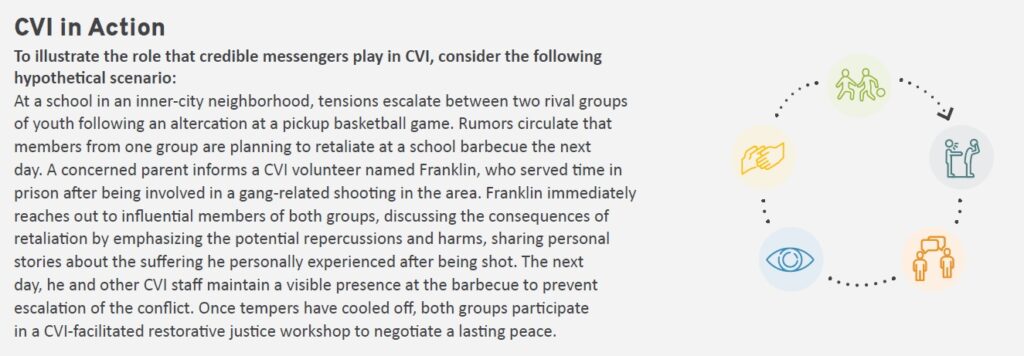
Bipartisan Consensus
Historically, CVI programs have mostly been implemented in liberal urban centers. Recent experiments in red states have been encouraging, demonstrating CVI’s adaptability to different political environments and compatibility with bipartisan values such as fiscal restraint and local control. CVI programs recognize that community members will always understand the idiosyncratic circumstances that give rise to violence better than federal, state, or even municipal law enforcement officials. In other words, those closest to the problem are best positioned to find solutions, and there is no such thing as one-size-fits-all. One example of CVI’s ideological diversity is Stick Talk, a form of “gun harm reduction” founded by former victims and second amendment advocates who were dissatisfied with CVI’s traditional abstinence-based approach to gun ownership. In contrast, Stick Talk responds to urban violence without demonizing firearm possession, which demonstrates the versatility of CVI programs for policymakers looking for bipartisan solutions. Empowering local leaders to manage and resolve issues internally, instead of through the formal justice system, expands individual freedom and diminishes the role the state plays in the day-to-day lives of individuals.
Fiscal Benefits
Youth violence is costly across every conceivable metric. Preventing it has ripple effects that produce compounding cost savings across the healthcare, criminal justice, and social welfare systems. Gunshots wounds, for example, are complex injuries that are expensive to treat and manage. Nationally, youth homicides and nonfatal physical assault-related injuries resulted in an estimated economic impact of $122 billion in 2020, including medical care, lost work, and productivity costs. As a result of the expansion of Medicaid under the Affordable Care Act, the government has become the primary insurer for victims of violence, paying for nearly 40 percent of emergency room visits. Thus, taxpayers now shoulder a significant share of these medical costs, particularly for severe injuries that require long-term services and support. From a first principles perspective, preventing even a small proportion of these injuries would produce meaningful savings in the healthcare system.
Addressing delinquent behavior before it requires punitive measures can pay for itself over time. Fewer assaults and homicides mean fewer police investigations, court trials, and juveniles sent to detention, which relieves the burden on limited criminal justice resources. The average juvenile detention cost in the United States is now $588 per day, or $214,620 per year—a 44 percent increase from a decade ago, and costs are substantially higher in some states. There are also hidden costs beyond the immediate medical and legal bills. Youth who experience violence as victims, perpetrators, or witnesses are more likely to develop behavioral and mental health difficulties, including post-traumatic stress, smoking, substance use, obesity, high-risk sexual behavior, depression, and suicide. This population is also over twice as likely to be victimized in the future. Consistent childhood exposure to trauma can be detrimental to every aspect of life, from mental health to academic achievement. Taken together, the innumerable downstream costs related to a single homicide can amount to over $1 million. Considering the high cost of gun violence, researchers estimate CVI programs return $7.20 to $19.20 in economic benefits for every $1 invested. It is clear that as with other types of deregulation, displacing the omnipresent “criminal justice-industrial complex,” with a private sector solution produces savings over time.
Smaller Government
By putting violence prevention in the hands of individual citizens and organizations, CVI embodies a true limited-government approach to juvenile justice. CVI programs are often supported by private and philanthropic funding, minimizing government spending in favor of private sector, free market solutions. CVI programs can capitalize on preexisting community assets, such as local churches, community centers, and nonprofit facilities, which can provide space and services at reduced rates or even for free and maximize the impact of each dollar spent. In addition to reducing the need for heavy-handed government intervention, CVI programs also promote personal responsibility and individual agency, requiring young people to take ownership of their lives and communities. This not only reduces reliance on government, but builds stronger, more cohesive communities capable of self-regulated conflict resolution. Furthermore, CVI programs provide former felons with a meaningful career, one uniquely suited to their life experience. Research studies demonstrate that one of the best ways to reduce adult recidivism is stable employment. Yet the average unemployment rate for ex-prisoners is over 27 percent—higher than the national rate during the Great Depression. Giving former offenders a productive career creates a pathway to rehabilitation for the millions of incarcerated individuals in the United States. In fact, applying for a CVI job is one of the only places where a criminal conviction is an asset rather than a liability.
CVI Evaluation
If we treat violence as a public health issue, the standard for research rigor should match that of any other health intervention. However, due to the nature of violence prevention, measuring the impact of CVI is challenging. Simply comparing outcomes for a group that received a treatment versus one that did not can introduce selection bias. This can be a particularly tricky problem in CVI evaluation. After all, programs are supposed to actively screen for certain characteristics, which is perhaps the very definition of “selection bias.” This is a problem for the entire field of CVI evaluation but is rarely discussed in the literature. These kinds of methodological concerns can affect the willingness of stakeholders to support or continue funding CVI programs.
Luckily for policymakers and criminal justice professionals, a huge amount of fresh research—including randomized control trials (RCTs)—has been conducted and published in the past few years. According to this new evidence, CVI can significantly reduce both violence and recidivism for at-risk youth. Below is a quick reference guide to the most rigorous of these studies from the past five years, including their methodology, program details, and key findings. To be eligible for inclusion in this analysis, studies must contain one or more quantitative estimates of a CVI program’s impact, either on youth violence or juvenile justice involvement.
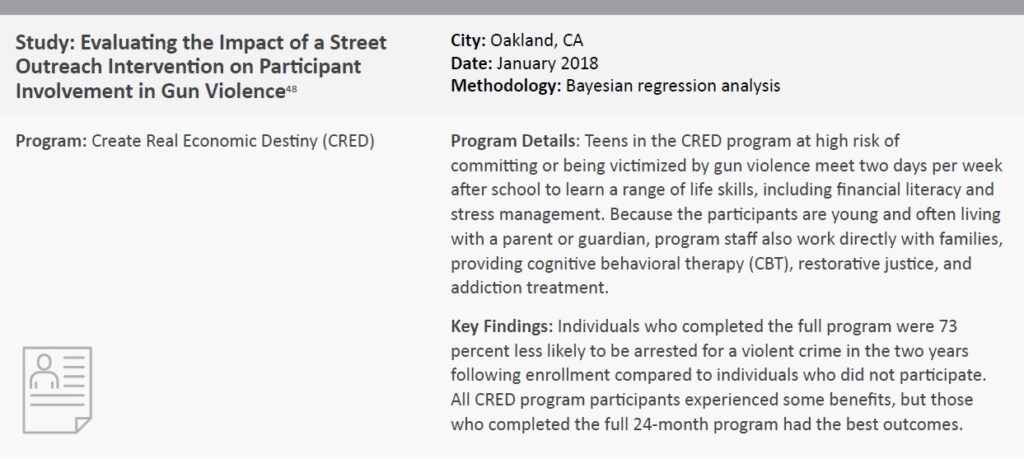
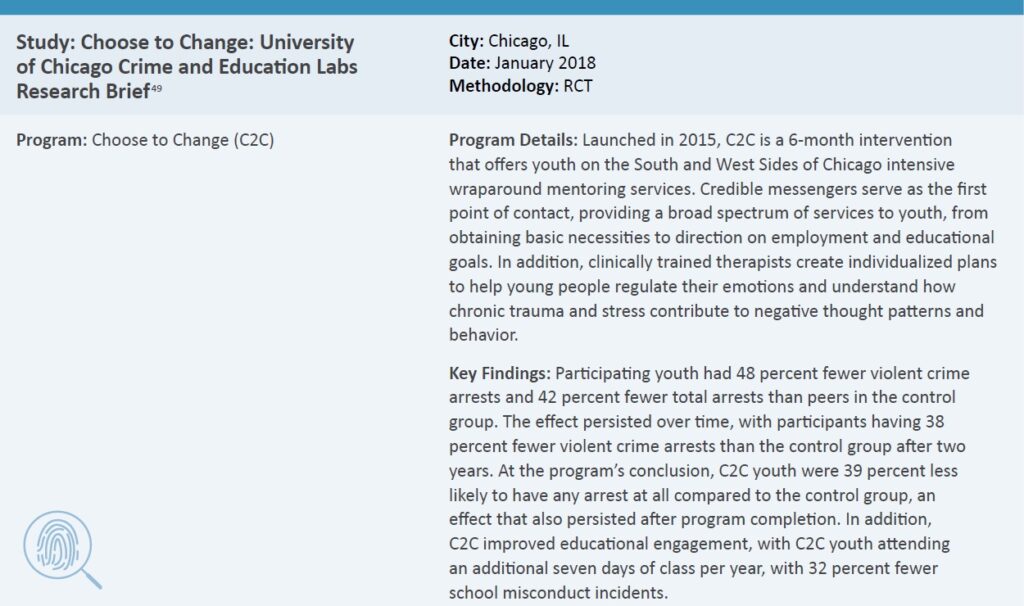
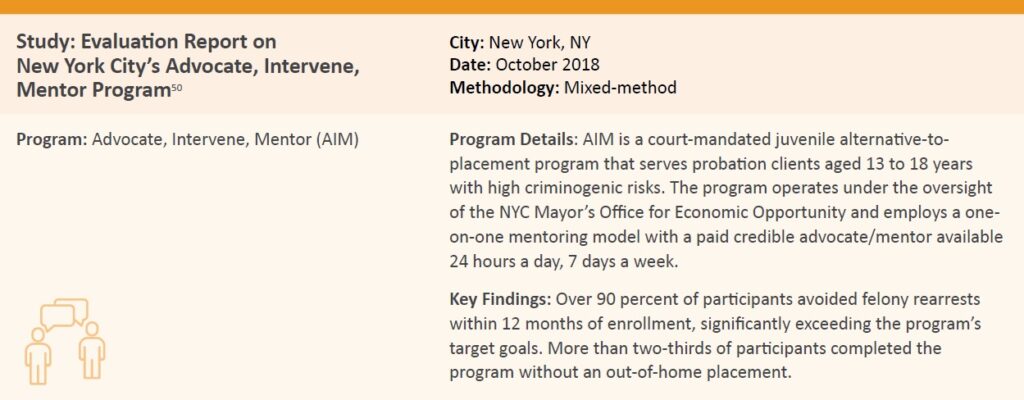
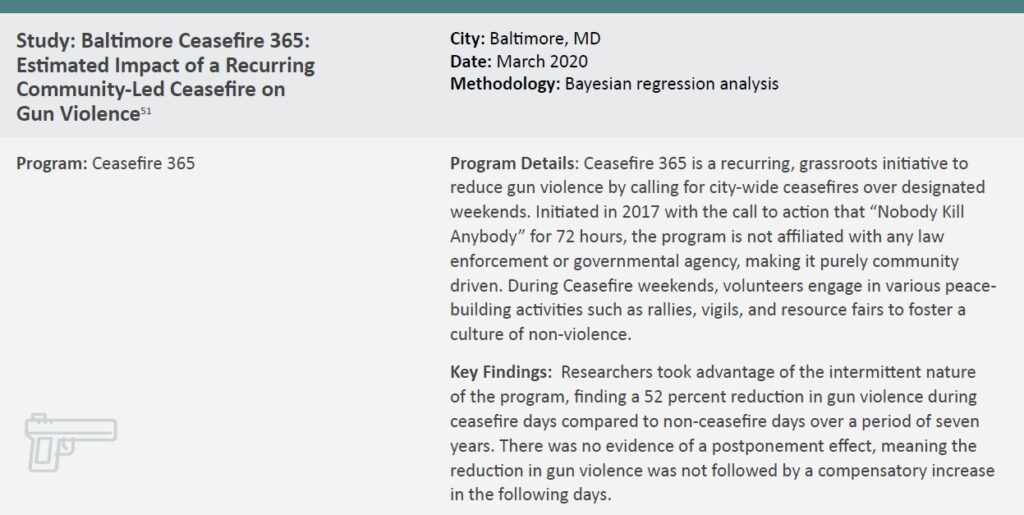
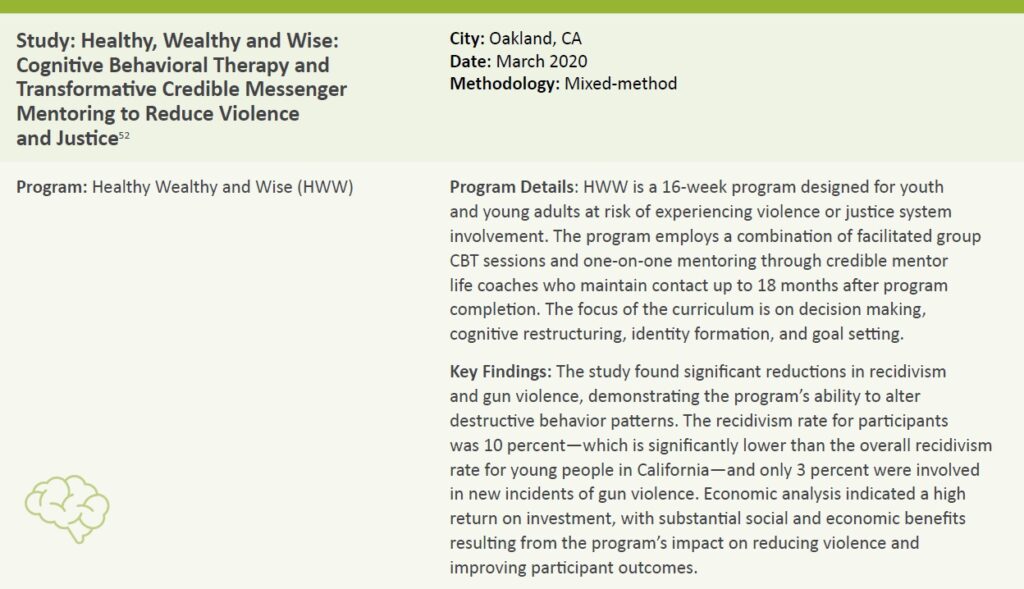
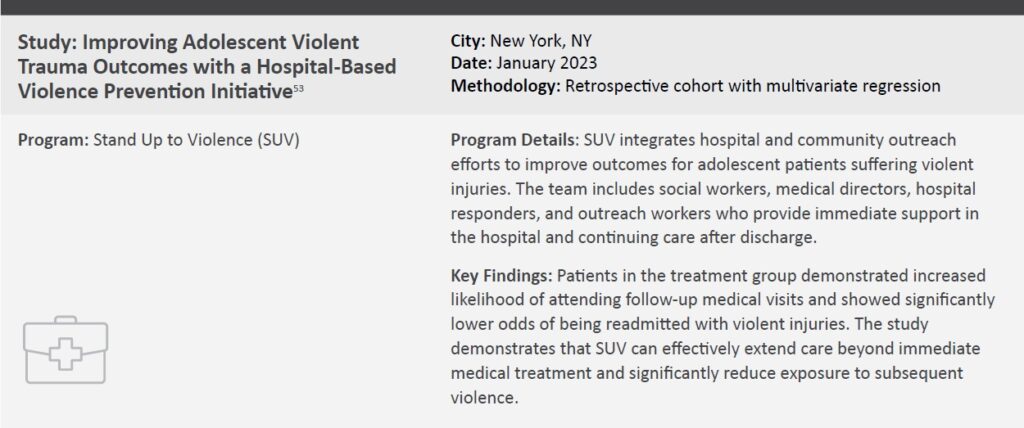
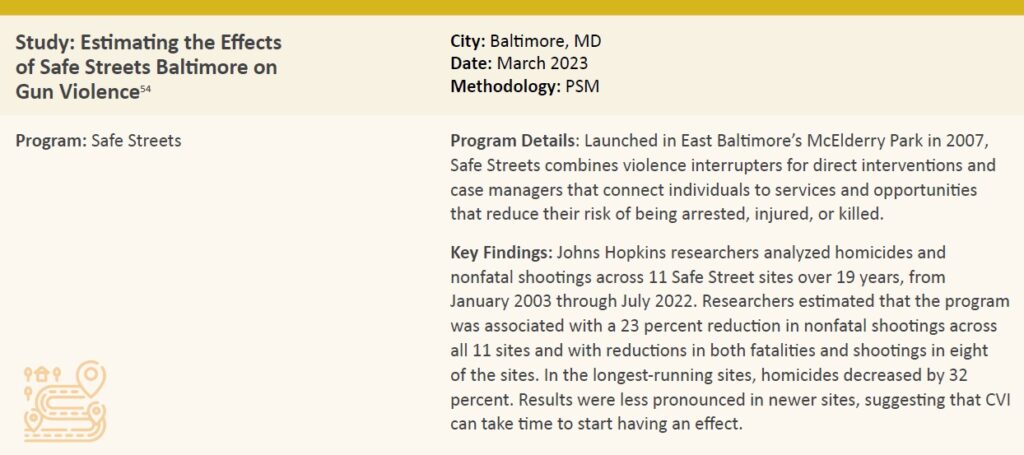
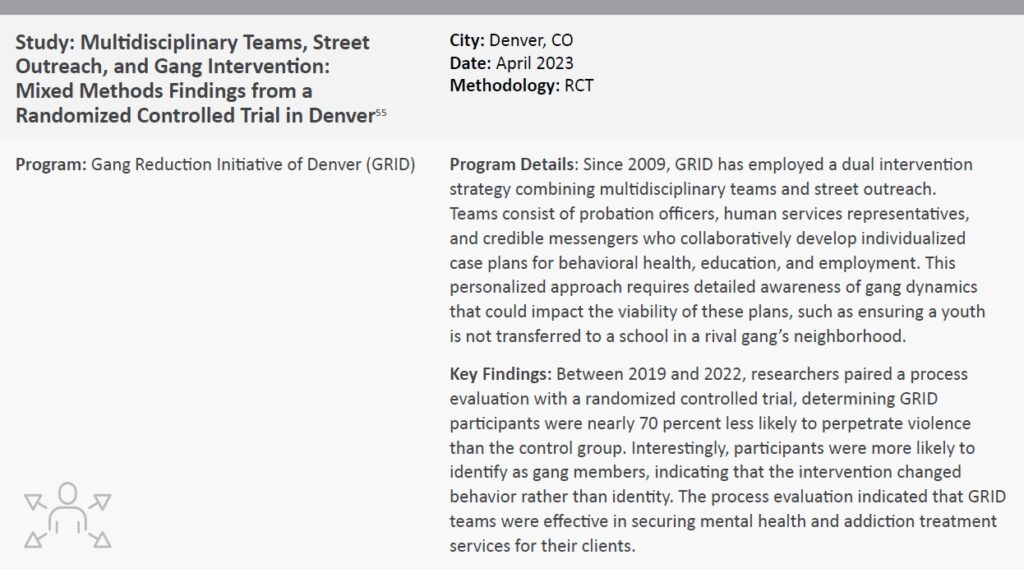
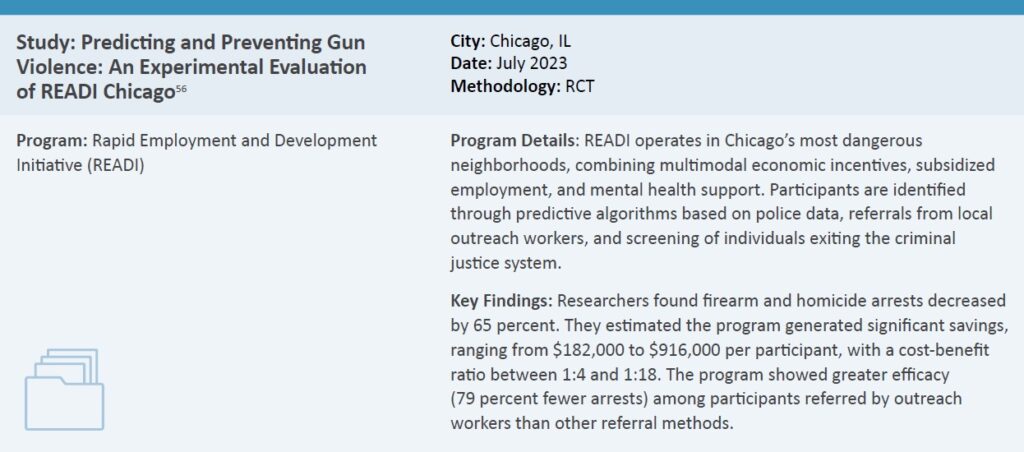
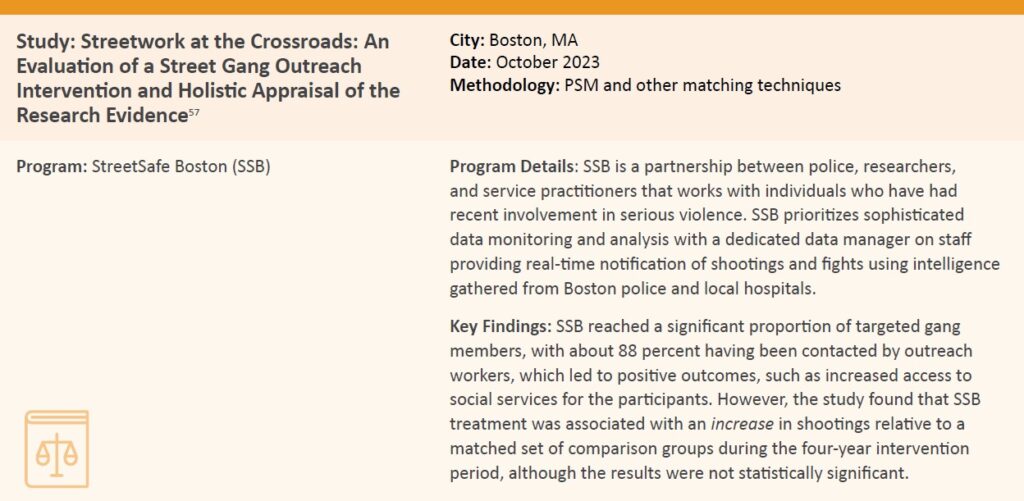
CVI Challenges
(Un)Safe Streets
Working day in and day out around violence can come at a high price. In 2021, Dante Barksdale, a leader in Baltimore’s Safe Streets’ program, was gunned down while on the job. The target of the shooting was a young man Barksdale was trying to help, but the killers fired indiscriminately at the corner where the two were standing. Over the course of the next 12 months, Safe Streets violence interrupters Kenyell Wilson and DaShawn McGrier were also shot to death. The attacks, while unconnected, prompted widespread soul searching in the CVI community, raising safety concerns and questions about whether enough was being done to protect workers. After an internal review, bulletproof vests were made available for workers during night shifts, but many refrain from wearing them, fearing the vests make them look too much like police officers. The emotional and physical toll of prolonged exposure to high-stress working conditions has led to high turnover rates among staff, affecting the consistency and reliability of program delivery.
Between Two Worlds
The murders of Safe Streets workers underscore a core challenge of CVI, namely the tension inherent in asking violence interrupters to straddle two worlds simultaneously. CVI workers must maintain familiarity with street-level dynamics of crime without getting personally involved. Meanwhile, they need to work with law enforcement while visibly maintaining their independence at the same time. This delicate balance requires diplomacy, interpersonal acumen, and a high degree of emotional intelligence, especially in communities with a deep-seated distrust of authorities. While some CVI programs operate independently of law enforcement, most require some level of collaboration with police. Police have real-time intel that can help identify brewing conflicts that outreach workers can mediate. As first responders, police also have immediate access to family members following an incident; if they are willing to allow CVI personnel that same access, the workers have the opportunity to directly tamp down talk of retaliation, console survivors, and immediately link loved ones to grief or crisis services.
However, too close of a relationship between CVI staff and police can compromise the perceived credibility of staff, which is a serious problem when credibility is the primary job qualification. Youth may not be inclined to participate if they view credible messengers as informants working for the police. Walking the line between serving as a trusted resource while maintaining a working relationship with law enforcement is a challenge every CVI program must navigate. Staff must carefully communicate with young people that their role is to save lives, not to investigate crimes. On the other side of the equation, they must be careful to avoid interfering with police investigations or encroaching on law enforcement activities. Furthermore, police may be skeptical about entrusting former offenders with youth or may perceive CVI staff as “protecting criminals” and undermining their authority. After all, program participants, and sometimes even the outreach workers themselves, may have been the focus of criminal investigations in the past. Getting buy-in from local law enforcement, particularly among rank-and-file officers, can be difficult, but friction and misunderstandings can be avoided by methodically delineating organizational responsibilities at the outset. It pays for everyone to have a clear understanding that CVI programs and law enforcement are complementary, not antagonistic.
Funding
In addition to dangers faced by workers and tensions with law enforcement, CVI programs have faced inconsistent and inadequate funding, relying on temporary or fluctuating income sources, which can affect a program’s ability to sustain their interventions. Additionally, some policymakers have been hesitant to invest in initiatives that employ individuals with criminal records, further complicating programs’ financial outlooks. That began to change in 2022, when the Department of Justice launched the Community-Based Violence Intervention and Prevention Initiative (CVIPI), which awarded nearly $200 million in grants in FY22 and FY23, funded by the Bipartisan Safer Communities Act. Then, after the Biden administration announced that states would be permitted to use Medicaid funding to support CVI programs, California, Colorado, Connecticut, Illinois, Maryland, New York, and Oregon passed laws approving the use of Medicaid money for violence prevention. Hospital-based violence intervention programs are the most obvious fit for Medicaid reimbursement, but any CVI model that provides long-term health services—such as CBT—is also eligible. Leaders are heavily investing in CVI, with states like Illinois dedicating up to $400 million with the goal of reducing homicides by 75 percent over the next 10 years.
Recommendations
Conclusion
By integrating principles of public health, social work, and community activism to directly address the root causes leading to youth violence, CVI programs offer a transformative blueprint for shifting responsibility from state mechanisms to localized, community-driven solutions. Empowering communities to end violence, either by themselves or in tandem with law enforcement, alleviates the burden on overworked and understaffed police departments. By leveraging the unique insights and experiences of credible messengers, CVI provides young people with a tangible example—perhaps their first—that a better future is possible. The research from the past five years has taken the evidence on CVI effectiveness to a new level, eliminating virtually any doubt as to whether these programs work. Violence is better addressed through community collaboration rather than the justice system alone. As policymakers continue to seek bipartisan strategies to combat youth violence, CVI stands out as a compelling option for anyone interested in saving lives
